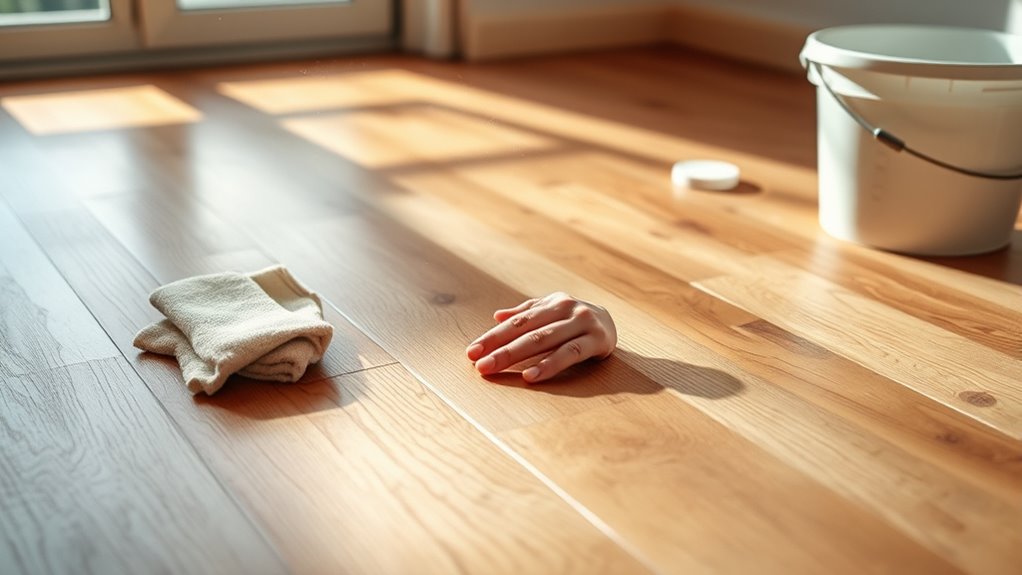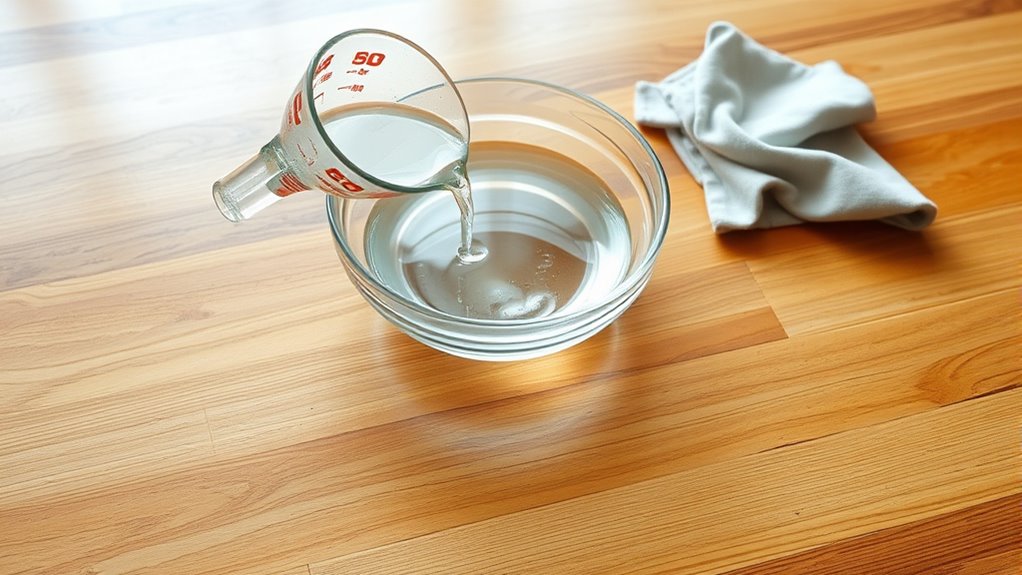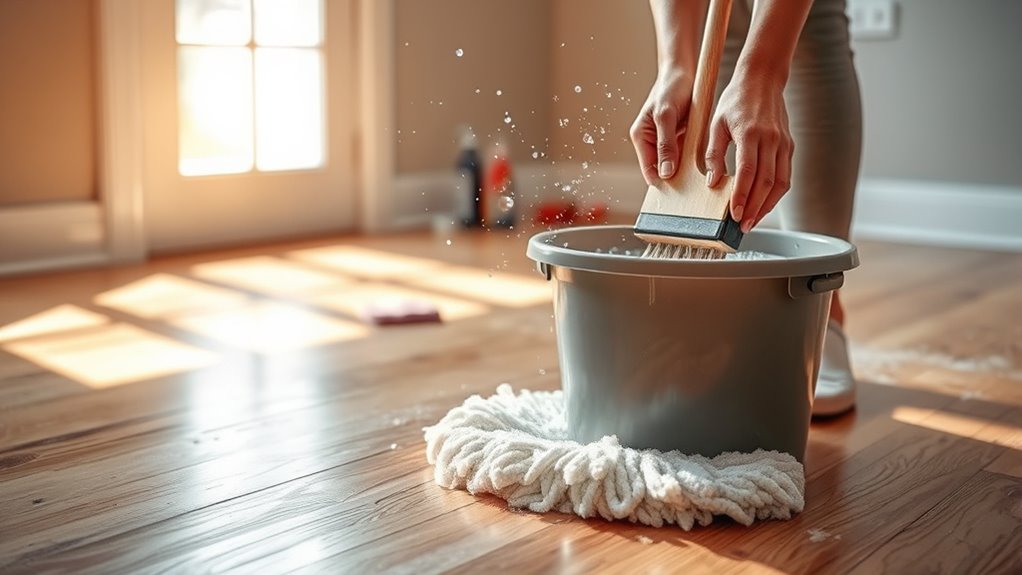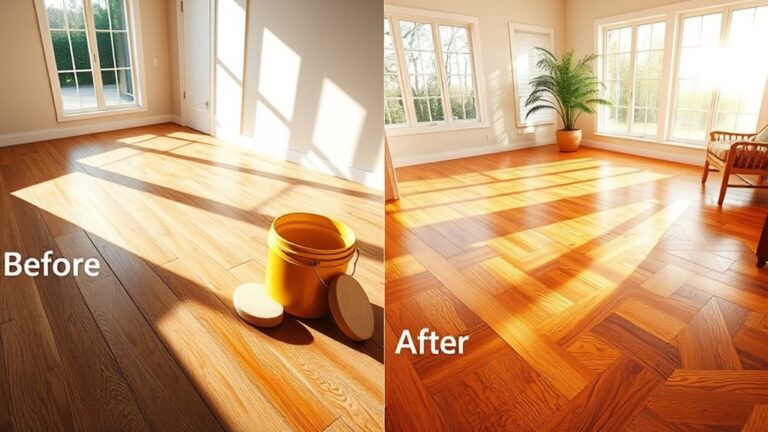Start by inspecting your unfinished hardwood for damage or dirt buildup. Use a soft broom or microfiber mop to remove dust gently, avoiding scratches. Prepare a mild, pH-neutral cleaning solution—like diluted white vinegar or natural soap in warm water—ensuring it’s not too wet. Clean small sections along the grain with a damp mop, then dry immediately with a clean cloth. Proper ventilation and humidity control help preserve the wood. Following these steps sets the foundation for deeper care techniques.
Assess the Condition of Your Unfinished Hardwood Floors

Before you begin cleaning, carefully assess the condition of your unfinished hardwood floors to determine the appropriate methods and products. Conduct a thorough floor inspection by examining the surface for signs of wear, scratches, stains, or moisture damage. Use proper lighting and a magnifying tool if necessary to identify subtle imperfections. Document the extent and location of any damage to guide your cleaning approach. During your damage assessment, note areas with dirt buildup versus structural concerns, as these require different treatments. This step guarantees you avoid using harsh chemicals or excessive moisture that could worsen damage. By performing a precise floor inspection and damage assessment, you maintain control over the cleaning process, preserving your floor’s natural integrity and granting you the freedom to tailor care techniques effectively.
Gather Necessary Cleaning Supplies
You’ll need specific tools like a soft-bristle broom, a vacuum with a hardwood floor attachment, and microfiber cloths for effective cleaning. Choose cleaning solutions that are pH-neutral and designed for unfinished hardwood to avoid damage. Having these supplies ready guarantees you clean thoroughly without harming the wood.
Essential Cleaning Tools
Although unfinished hardwood floors require special care, gathering the right cleaning tools makes maintenance straightforward and effective. Start with a soft-bristle broom or a microfiber dust mop to remove dirt and debris without scratching the surface. Avoid stiff brushes or vacuum attachments with beater bars, as they can damage the wood. Next, use a lint-free cloth or microfiber mop for gentle cleaning, ensuring no excess water is applied. A handheld vacuum with a hardwood floor setting can also be useful for tight corners. Keep a bucket handy for wringing out your mop, preventing over-wetting. By assembling these essential cleaning tools, you’ll maintain your unfinished hardwood floors’ integrity, ensuring freedom from damage while preserving natural beauty. Proper hardwood maintenance starts with the right equipment.
Safe Cleaning Solutions
With the right tools in hand, selecting safe cleaning solutions becomes the next priority for maintaining unfinished hardwood floors. You’ll want to focus on natural ingredients and eco friendly options to protect the wood’s porous surface without causing damage. Avoid harsh chemicals that can strip or discolor the floor.
Here’s a quick guide to safe cleaning solutions:
| Solution | Key Features |
|---|---|
| Vinegar & Water Mix | Mild acidity, natural, cheap |
| Castile Soap Solution | Gentle, plant-based, effective |
| Commercial Eco Cleaners | Certified, non-toxic |
Use these solutions diluted properly and always test in a small area first. This approach guarantees your unfinished hardwood floors stay clean while preserving their natural beauty and your freedom to maintain them safely.
Remove Dust and Loose Dirt

Start by using a soft-bristled broom to gently sweep away dust and loose dirt without scratching the unfinished wood. If you use a vacuum, make sure it has a hardwood floor attachment to prevent damage. Employ dry dusting techniques to capture fine particles without adding moisture to the surface.
Use Soft-Bristled Broom
One essential tool for maintaining unfinished hardwood floors is a soft-bristled broom, which effectively removes dust and loose dirt without scratching the surface. The soft broom benefits include gentle contact that preserves the wood’s texture and prevents damage. To maximize cleaning techniques, follow these steps:
- Use long, even strokes to gather debris efficiently.
- Avoid pressing too hard to prevent bristle wear.
- Sweep in the direction of the wood grain.
- Clean the broom regularly to avoid redistributing dirt.
- Target corners and edges where dust accumulates.
Vacuum With Care
Although vacuuming can efficiently remove dust and loose dirt from unfinished hardwood floors, you’ll need to use the right attachments and settings to avoid scratching or damaging the surface. Start by selecting vacuum attachments designed for delicate flooring—soft brush tools work best. Avoid beater bars or rotating brushes, as they can gouge the wood. Adjust vacuum settings to the lowest suction appropriate for your model to prevent lifting or damaging floorboards. Move the vacuum slowly and evenly across the floor, ensuring you cover all areas without pressing too hard. Inspect the vacuum head for debris or rough edges before use to maintain floor integrity. By carefully managing vacuum attachments and settings, you’ll preserve your unfinished hardwood’s texture while effectively removing dust and loose dirt.
Dry Dusting Techniques
When you need to remove dust and loose dirt from unfinished hardwood floors without moisture, dry dusting techniques offer an effective solution. These methods prevent moisture damage and maintain floor integrity. Start by selecting tools that capture dust without scratching the surface. Use these dusting techniques for ideal results:
- Microfiber dust mops designed for hardwood floors
- Soft-bristle broom with fine bristles
- Electrostatic cloths that attract particles
- Vacuum cleaners with hardwood floor attachments
- Natural cleaners in powder form to absorb dust
Employ these tools methodically, moving along the wood grain to avoid residue buildup. Dry dusting preserves the floor’s unfinished character while freeing you from water-related risks. Staying consistent with these precise, natural dusting techniques guarantees your floors remain clean and ready for finishing or sealing.
Prepare a Gentle Cleaning Solution

Since unfinished hardwood floors are highly absorbent, you’ll need to use a gentle cleaning solution that won’t saturate or damage the wood. Start by mixing warm water with a small amount of mild soap derived from natural ingredients, such as castile soap. Avoid harsh chemicals or detergents. For an eco friendly option, you can combine one cup of white vinegar with one gallon of warm water, which effectively cleans without leaving residue. Always stir the solution thoroughly to guarantee even dilution. Use this gentle mixture sparingly during cleaning to prevent over-wetting. Preparing this solution correctly will protect the wood’s integrity while allowing you freedom from harsh, synthetic cleaners. Keep your mixture ready in a spray bottle or bucket for controlled application during the cleaning process.
Clean the Floors Using Proper Techniques
Start by dampening a microfiber mop or soft cloth with your prepared cleaning solution, ensuring it’s only slightly moist to prevent water damage. Employ these cleaning techniques for effective floor maintenance:
- Work in small sections to evenly clean the surface.
- Move the mop or cloth along the wood grain to avoid scratches.
- Avoid over-saturating the floor to prevent warping or staining.
- Use gentle, consistent pressure to lift dirt without damaging the wood.
- Rinse and wring your mop or cloth frequently to maintain cleanliness.
Dry and Maintain Your Unfinished Hardwood Floors
After cleaning, promptly dry the floor using a clean, dry microfiber cloth or mop to remove any residual moisture. Unfinished hardwood is highly susceptible to water damage, so thorough drying prevents warping and staining. For effective floor maintenance, establish a cleaning frequency based on foot traffic—typically once a week for moderate use. Avoid harsh chemicals and excessive water during cleaning to preserve the wood’s integrity. Regularly inspect your floors for dirt buildup or scratches, addressing these promptly to maintain ideal condition. Use protective pads on furniture to prevent gouging. By adhering to a consistent cleaning frequency and proper drying techniques, you’ll guarantee your unfinished hardwood floors remain durable and visually appealing while maintaining the freedom to customize finishes in the future.




